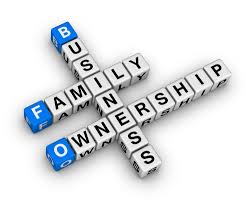 We often use the term “family business” without having a clear definition of just what a family business really is. Coming up with such a definition is more difficult than it might at first seem, but it would be helpful for any number of reasons.
We often use the term “family business” without having a clear definition of just what a family business really is. Coming up with such a definition is more difficult than it might at first seem, but it would be helpful for any number of reasons.
A generally-recognized definition of family business as well as a means of classifying these businesses is a requirement for scholastic analysis of this type of organization. Without the ability to define the subject and differentiate between types of family firms it becomes extremely challenging to research the category and to make it a subject for academic study.
Governments also need a definition of a family business for the purposes of collecting statistical data about this sector and for determining liability for taxation.
Researchers have traditionally started their definition of a family business by looking at the three areas of involvement in a business: ownership, management and succession from one generation to the next.
Every definition raise questions. The basis is usually seen as ownership by members of a family, but that raises a number of other questions such as:
– Does the family have to own 100% of the business, or simply own a majority of the business?
– Does the family have to manage the business as well as own it?
– Is the certainty of succession essential or can it be just a possibility subject to future developments?
– Is it necessary that the future of the business is planned by members of a family or can the business be guided externally?
– Is the size of the enterprise relevant — turnover, number of employees, and so forth?
– Is a sole proprietorship a true “family business” in that it is owned by a member of one family?
Jess Chua, professor of family business management at the University of Calgary in Canada, says that “The family business is a business governed and/or managed with the intention to shape and pursue the vision of the business held by a dominant coalition controlled by members of the same family or a small number of families in a manner that is potentially sustainable across generations of the family or families.”
The Taxman’s Perspective
The US Internal Revenue Service offers a more ownership-based definition to enable calculation of taxes on deceased estates: “A qualified family-owned business includes a sole proprietorship as well as an entity such as a corporation, partnership, or limited liability company that conducts a trade or business.
“If the business is an entity rather than a sole proprietorship, the decedent and his or her family members must own any of the following: (1) at least 50% of the entity; (2) at least 30% of an entity in which members of two families own 70%; or (3) at least 30% of an entity in which members of three families own 90%.”
Writing in the Family Business Review, Melissa Carey Shanker and Joseph H. Astrachan point out that a common definition of what constitutes a family business does not exist. They conclude there are three family business types, depending on whether the defining criteria are broad, middle or narrow.
The broadest and most inclusive definition requires that the family have some degree of effective control over strategic direction, and that the business is at least intended to remain in the family. This definition includes businesses where a family member is not in direct daily contact with the business but influences decision-making, perhaps through board membership or significant stock ownership.
The middle division would include all the criteria of the broadest group and would require that the founder or descendant runs the company. Again, this definition would include those businesses where only one member of the family is directly involved in the day-to-day operations.
The narrowest family business definition would require that the business have multiple generations involved, direct family involvement in daily operations, and more than one family member having significant management responsibility.
The Three Domains
At Purdue University’s Initiative for Families in Business, the definition of a family business is sought within what are termed the three “domains” — family, business and ownership.
The “family” domain is based upon people being related by blood, by adoption or by marriage. The “business” domain is based upon the structure being a profit-driven economic unit that functions as a commercial enterprise. The “ownership” domain requires legal claim to the assets of the business risking those assets in the hope/expectation of making a profit.
The University concludes that unique thing about a family business is the involvement of family members in more than one domain. One domain is insufficient for achieving family business’ status, but the family’s involvement in two or three domains qualifies the organization as a family business.
External shareholders, managers and guidance are all possible. The two-domain combinations of family businesses therefore are:
Family + Business= employed family members, not owners.
Family + Owner= family stockholders who do not work in the business.
Business + Owner= employee stockholders.
Also possible is the three domain combination:
Family + Business + Owner= family member involved in all three domains; generally the founder fits here while still active in the business
As has been shown, there is no single agreed definition of precisely what constitutes a family business. Several definitions exist but none can be truly said to cover all businesses that are considered “family businesses” in their own environment.
A Possible Conclusion
Distilling the existing definitions into a concise framework that could be hoped to apply in the great majority of cases, the following definition seems appropriate:
– The enterprise is an economic unit that functions commercially with the intention of making a profit;
– Majority ownership of the enterprise rests with a member or members of a single family that are related by blood, adoption or marriage;
– Management control of the enterprise is exercised in whole or in part by a member or members of a single family;
– The strategic direction of the enterprise is determined in whole or in part by a member or members of a single family.
However it’s defined, the family business is probably the most common type of business that exists. Debates over definitions will continue, but there can be no doubt about the critical importance of the family business to every economy in the world.
Copyright 2005, RAN ONE Inc. All rights reserved. Reprinted with permission from www.ranone.com

 Chris’ combination of academic credentials, career experience and temperament ideally suit his calling as a business development advisor. Clients say he has a mind for business and a heart for service.
Chris’ combination of academic credentials, career experience and temperament ideally suit his calling as a business development advisor. Clients say he has a mind for business and a heart for service.